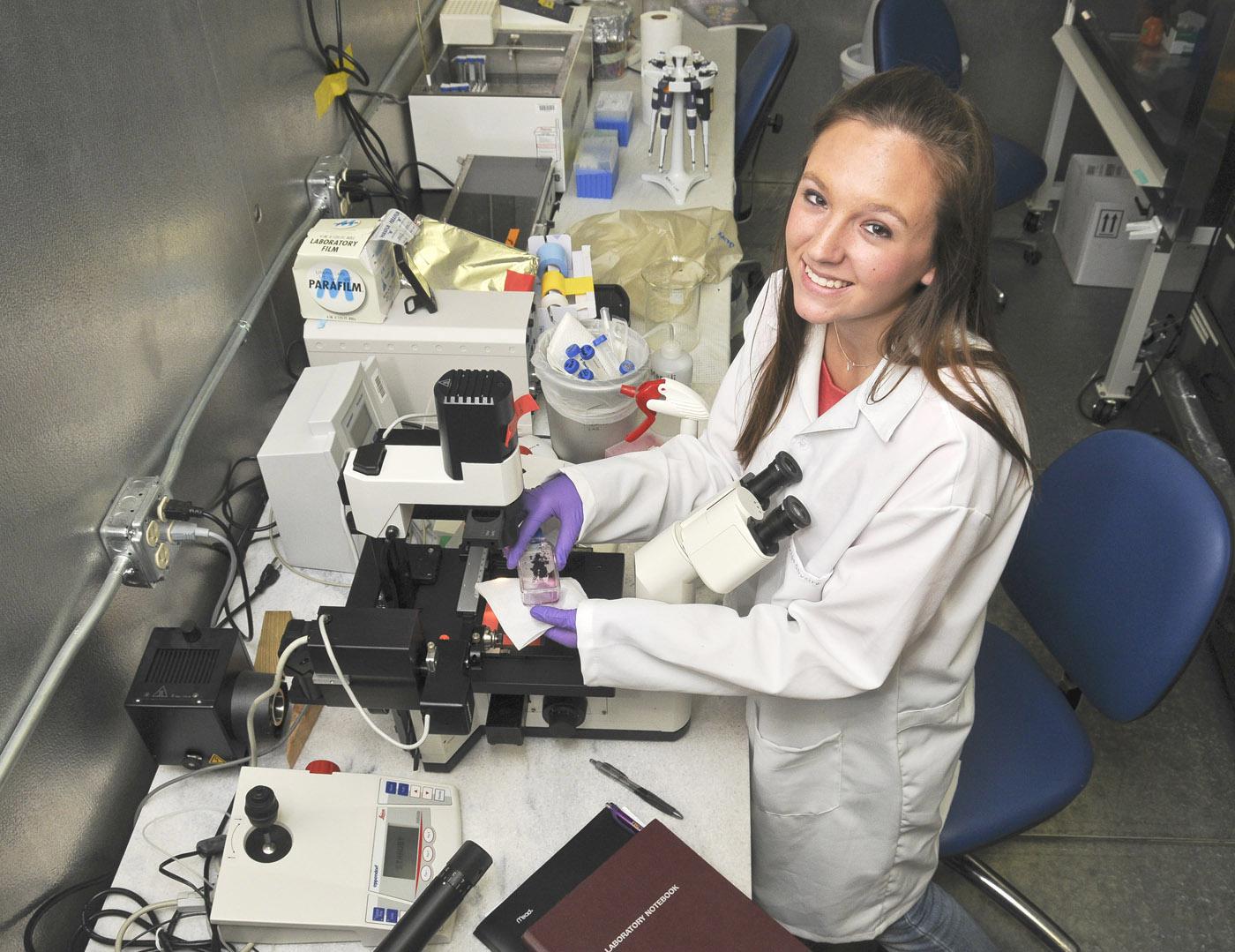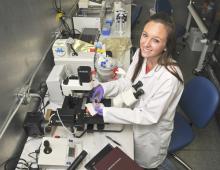Information Possibly Outdated
The information presented on this page was originally released on May 3, 2012. It may not be outdated, but please search our site for more current information. If you plan to quote or reference this information in a publication, please check with the Extension specialist or author before proceeding.
High school student researches stem cells
MISSISSIPPI STATE – Not many 17-year-olds spend their free time doing stem cell research, but an interest in helping special-needs children brought Brenna Nye to Mississippi State University to do just that.
Nye, a high school junior from Southaven, traveled weekly this semester from the Mississippi School for Math and Science’s campus in Columbus to MSU’s Department of Animal and Dairy Science to conduct biomedical research. She worked under the direction of Dr. Erdogan Memili of the College of Agriculture and Life Sciences, who specializes in the functional genomics of animal reproduction and development, and doctoral student Aruna Govindaraju.
“My passion is to mentor students, and I’ve been treating Brenna like a graduate student,” Memili said. “Brenna takes pig fat tissue and processes it through several steps to isolate adipose-derived stem cells. She then cultures the cells to let them proliferate. We cryopreserve some and do further experiments with the rest.
“With minimal guidance from me, she developed a graduate-level proposal with clear objectives and is motivated to pursue her hypothesis. She has a very curious mind and can communicate scientific concepts clearly,” Memili said.
Nye is one of 13 students selected for the MSU/MSMS research program that is facilitated by Teresa Gammill, assistant vice-president for research at MSU.
“This effort is a winning situation for the student, the faculty member or researcher and MSU -- the student is gaining research experience, while MSU is recruiting gifted and academically able students from across Mississippi,” Gammill said.
Sixty students applied, and 35 names were sent to Gammill’s office for matching with mentors. Thirteen student researchers were placed at MSU.
“I applied for the genetics program because I have a strong background in science, and I’ve worked with special-needs kids,” Nye said. “I understand that genetics could be involved in the various challenges they face, and stem cell research was a natural fit for me.”
In her studies, Nye learned that stem cells had been used to regenerate knee tissue in rabbits with an injury similar to a torn meniscus.
“Because of their potential to regenerate, stem cells offer an alternate to surgery or years spent waiting for an organ donor,” Nye said. “Adipose-derived stem cells are unique. They are easy to acquire because they come from fat, not embryos. All animals and humans have fat.”
Another advantage is that the fat tissue could be taken from the patient in need of the stem cells, reducing the chances of rejection.
“Stem cells offer numerous advantages over regenerative medicine,” Nye said. “They also have great potential for enhancing human and animal health.”
Thomas Easterling, director of mentorship and research programs at MSMS, said students in the MSU/MSMS research program have completed projects in a variety of disciplines, but most involve science and engineering.
“The program requires students to spend 35 contact hours over the course of the semester,” Easterling said. “That Brenna has already spent about 70 hours speaks of her appetite for learning. Dr. Memili has really challenged her, but she has risen to the occasion.
“Brenna is marvelously well-rounded. She earned a letter on the MSMS soccer team, she’s talented musically, she’s active in her church, she has spent time working at summer camps for autistic children – and she’s a great student,” he said.
After MSMS, Nye plans to pursue a degree in biology or biomechanical engineering.
“My research helped me understand more about what career options are available and will help me make future decisions,” she said. “I would like to study the genetics of autism and find ways to help people with other special needs. I think stem cells have the potential to bring about an entirely new branch of regenerative medicine.”



